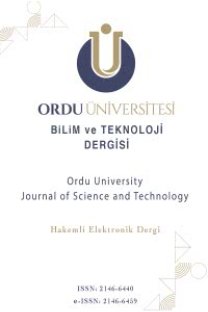Burgers ve coupled Burgers denklemlerinin tam ve nümerik çözümleri üzerine
Bu çalışmada, bir boyutlu Burgers denklemi ve Burgers denklemler sistemi Homotopi pertürbasyon metodu (HPM) ile çözülmüştür. Elde edilen çözümlerin iki ve üç boyutlu grafikleri ve tabloları Mathematica hesaplama programı yardımıyla oluşturulmuştur. Bu çalışmada bulunan tüm çözümler metodun etkinliğini doğrulamaktadır. Sonuçlara göre, elde ettiğimiz çözümlerin analitik çözümlere çok hızlı bir şekilde yakınsadığı ortaya çıkarılmıştır. Sonuç olarak, sunulan metodun geniş aralıktaki lineer olmayan problemlerin çözümleri için uygulanabilir olduğunu ifade etmemiz mümkündür.
Anahtar Kelimeler:
bir boyutlu Burgers denklemi, Coupled Burgers denklemi, Homotopi pertürbasyon metodu, yerleştirilen parametre
On Exact and Numerical Solutions to the Burgers' and Coupled Burgers' Equation
In this work, one dimensional Burgers' equation and coupled Burgers' equation are solved via Homotopy perturbation method (HPM). Solutions two and three-dimensional graphics and tables of some obtained results are constructed with the help of the computational program in the Wolfram Mathematica. All the solutions found in this study validate the efficiency of the method. According to the results, we have found out that our gained solutions convergence very speedily to the analytical solutions. In conclusion, we can say that the present method can also be applied for the solutions of a wide range of nonlinear problems.
Keywords:
one dimensional Burgers, Coupled Burgers, Homotopy perturbation method, embedding parameter,
___
- Abbasbandy, S. (2007). The application of Homotopy analysis method to solve a generalized Hirota-Satsuma coupled KdV equation. Physics Letters A, 361(6), 478-483. https://doi.org/10.1016/j.physleta.2006.09.105
- Adomian, G. (1994). Solving Frontier Problems of Physics: The Decomposition Method. Kluwer Academic Publishers.
- Alomari, A. K., Noorani, M. S. M., & Nazar, R. (2008). The Homotopy analysis method for the exact solutions of the K(2,2), Burgers and Coupled Burgers equations. Applied Mathematical Sciences, 2(40), 1963-1977. http://www.m-hikari.com/ams/ams-password-2008/ams-password37-40-2008/alomariAMS37-40-2008.pdf
- Amirov, R., & Ergun, A. (2020). Half inverse problems for the impulsive singular diffusion operator. Turkish Journal of Science, 5(3), 186-198. https://dergipark.org.tr/en/pub/tjos/issue/59057/832057
- Babaoğlu, M. (2009). Diferansiyel denklemlerin sayısal çözümlerinde Adomian ayrışım metodu ve Homotopi analiz metodu’ nun karşılaştırılması [Yayımlanmış yüksek lisans tezi]. Kahramanmaraş Sütçü İmam Üniversitesi.
- Cole, J. D. (1968). Perturbation Methods in Applied Mathematics. Blaisdell Publishing Company.
- Ergun, A. (2020). The multiplicity of eigenvalues of a vectorial singular diffusion equation with discontinuous conditions. Eastern Anatolian Journal of Science, 6(2), 22-34. https://dergipark.org.tr/en/pub/eajs/issue/58365/783092
- Ergun, A. (2020). A half inverse problem for the singular diffusion operator with jump conditions. Miskolch Mathematical Notes, 21(2), 805-821. https://doi.org/10.48550/arXiv.2006.08329
- Esipov, S. E. (1995). Coupled Burgers equations: A model of polydispersive sedimentation. Physical Review E, 52(4), 3711-3718. https://doi.org/10.1103/PhysRevE.52.3711
- Ganji, D. D., & Rafei, M. (2006). Solitary wave solutions for a generalized Hitora-Satsuma coupled KdV equation by homotopy perturbation method. Physics Letters A, 356(2), 131-137. https://doi.org/10.1016/j.physleta.2006.03.039
- Ganji, D. D., & Rajabi, A. (2006). Assessment of homotopy-perturbation and perturbation methods in heat radiation equations. International Communications in Heat and Mass Transfer, 33(3), 391–400. https://doi.org/10.1016/j.icheatmasstransfer.2005.11.001
- He, J. H. (1999). Homotopy perturbation technique. Computer Methods in Applied Mechanics and Engineering, 178(3-4), 257-262. https://doi.org/10.1016/S0045-7825(99)00018-3
- He, J. H. (2004). Asymptotology by Homotopy perturbation method. Applied Mathematics and Computation, 156(3), 591-596. https://doi.org/10.1016/j.amc.2003.08.011
- He, J. H. (2004). Comparison of homotopy perturbation method and homotopy analysis method. Applied Mathematics and Computation, 156(2), 527-539. https://doi.org/10.1016/j.amc.2003.08.008
- Liao, S. J. (1992). The proposed homotopy analysis technique for the solution of nonlinear problems [Ph.D. Thesis]. Shanghai Jiao Tong University.
- Liao, S. J. (2004). On the homotopy analysis method for nonlinear problems. Applied Mathematics and Computation, 147(2), 499-513. https://doi.org/10.1016/S0096-3003(02)00790-7
- Liao, S. J. (2005). Comparison between the homotopy analysis method and homotopy perturbation method. Applied Mathematics and Computation, 169(2), 1186-1194. https://doi.org/10.1016/j.amc.2004.10.058
- Lyapunov, A. M. (1992). General problem of the stability of motion. Taylor and Francis.
- Nayfeh, A. H. (2000). Perturbation methods. John Wiley and Sons.
- Nee, J. and Duan, J. (1998). Limit set of trajectories of the coupled viscous Burgers’ equations. Applied Mathematics Letters, 11(1), 57-61. https://doi.org/10.1016/S0893-9659(97)00133-X
- Wazwaz, A. M. (2002). Partial differential equations: Methods and applications. Balkema Publishers.
- ISSN: 2146-6440
- Yayın Aralığı: Yılda 2 Sayı
- Başlangıç: 2011
- Yayıncı: ORDU ÜNİVERSİTESİ
Sayıdaki Diğer Makaleler
Asmalarda Yaprak Alma Sıklığının Sürgün Büyümesi, Verim ve Bazı Kalite Değerleri Üzerine Etkisi
Mehmet Settar ÜNAL, Hasan SEZGİN
Humik Asit ve Azotlu Gübrelemenin Marulun Besin Maddesi İçerikleri Üzerine Etkisi
Ceyhan TARAKÇIOĞLU, Merve BAŞ ODABAŞ
Burgers ve coupled Burgers denklemlerinin tam ve nümerik çözümleri üzerine
Salvia fruticosa Mill.’da İn Vitro Tohum Kültürü ile Aseptik Fide Üretimi
Emel YILMAZ GÖKDOĞAN, Müge ETİK, Betül BÜRÜN
